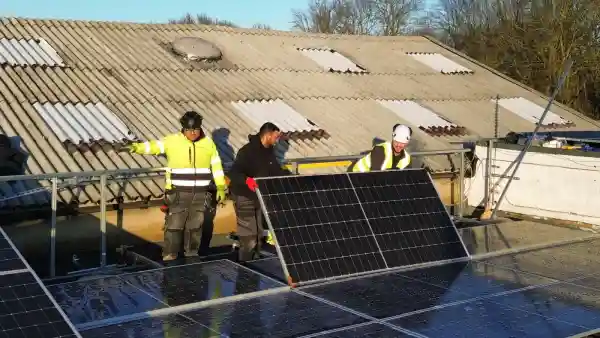
As I sit down to write this in 2025, the UK solar sector is experiencing a record-breaking boom. According to the UK Government’s Solar Roadmap (UK Government PDF), the country already has nearly 19 GW of installed solar capacity, with a target to reach 45–47 GW by 2030. That’s more than doubling capacity in just five years.
For electricians, the opportunity is huge. Solar PV isn’t just another string to your bow—it’s a fast-growing market where skilled, qualified professionals are in short supply. In this guide, I’ll show you exactly how to become a solar installer, the qualifications you’ll need, and why now is the perfect time to make the move. I’ll also share details of a major live project my organisation is delivering: the Holland Bazaar 250 kWp warehouse installation in Enfield, currently underway with our students at Learn Trade Skills in partnership with WireNow.
The UK’s solar market is growing faster than ever. Between January and May 2025 alone, the UK added 513 MW of new capacity, an 8.1% increase over the same period in 2024 (PV Magazine). Solar generation in Q1 2025 was 2.8 TWh, up 45% from last year.
Solar already provides around 5% of our total electricity, but on sunny days, it can exceed 30% (UK Government Solar Roadmap). With zero-VAT on installations, the Smart Export Guarantee (SEG) paying for exported energy, and households desperate to cut bills, the case for solar has never been stronger.
If you’re starting from scratch, you need to become a fully qualified electrician through this path. This means completing:
Without these, you cannot legally carry out electrical work in the UK, let alone solar installations. You can
Once you have your electrical qualifications, you’ll need to upskill in solar PV installation. The industry-standard is the Level 3 Award in the Installation of Small-Scale Photovoltaics. This typically takes 3–5 days for qualified electricians and covers:
Look for courses accredited by City & Guilds, LCL Awards, or EAL.
To legally sign off installations and allow customers to claim incentives, you must be MCS-certified. This involves:
Without MCS registration, you won’t be able to offer zero-VAT rates or SEG eligibility to clients—making your services far less competitive.
A typical domestic installation follows these steps:
Technical skills:
Soft skills:
In 2025, a typical 2–3 bedroom solar PV installation costs between £6,600 and £8,100 and can save a household up to £1,274/year on energy bills (Homebuilding & Renovating).
For electricians, solar PV is a high-margin service, especially when paired with battery storage. Opportunities are expanding in:
One of the most exciting projects I’ve been involved in this year is the Holland Bazaar warehouse solar installation in Enfield.
Our students have been:
Once live, this system will significantly reduce Holland Bazaar’s operating costs and carbon footprint. For our students, it’s a once-in-a-career early opportunity to work on a major commercial PV system before they’ve even completed training.
This project is living proof that when training is linked with real-world projects, we don’t just produce qualified installers—we produce professionals ready to deliver from day one.
With targets of 45–47 GW by 2030 and government encouragement for rooftop, commercial, and even balcony solar (The Guardian), the demand for installers will only grow.
Do I need to be an electrician first?
Yes—UK law requires you to have electrical qualifications before solar training.
How long until I can start installing?
If you’re already a qualified electrician, solar PV training can be completed in a few days, with MCS registration following soon after.
Are incentives still available?
Yes—zero-VAT on installations runs until at least 2027, and the SEG remains in place for exported energy.
Becoming a solar panel installer in the UK in 2025 is one of the most strategic moves you can make as an electrician. The market is expanding fast, the earnings potential is strong, and the work is meaningful.
Our live Holland Bazaar 250 kWp project shows exactly what’s possible when training is matched with real industry projects. Whether you’re just starting your electrical career or looking to upskill, now is the time to plug into solar and power the UK’s clean energy future.
Tolga Aramaz is the Director of Learn Trade Skills (LTS), a family-run training centre specialising in electrical installations. With years of experience and a deep understanding of the electrical industry, Tolga is known for their exceptional organisational skills, attention to detail, and commitment to delivering outstanding results. They provide valuable insights and guidance to electricians, contractors, and businesses, ensuring compliance with industry regulations and safety protocols. Through engaging training programmes and consultancy services, Tolga empowers professionals to excel in their roles, fostering long-term relationships built on professionalism and customer satisfaction.
“Lorem ipsum dolor sit amet, consectetur adipiscing elit. Ut pretium tristique purus nec consectetur. Nulla feugiat eget tellus aliquam scelerisque. Sed eget luctus enim, sed mattis enim. Lorem ipsum dolor sit amet, consectetur adipiscing elit. Ut pretium tristique purus nec consectetur. Nulla feugiat eget tellus aliquam scelerisque. Sed eget luctus enim, sed mattis enim.Nulla feugiat eget tellus aliquam scelerisque. Sed eget luctus enim, sed mattis enim. Lorem ipsum dolor sit amet, consectetur adipiscing elit. Ut pretium tristique purus nec consectetur. Nulla feugiat eget tellus aliquam scelerisque. Sed eget luctus enim, sed mattis enim.”
William Goss
Electrician course
11/11/2024